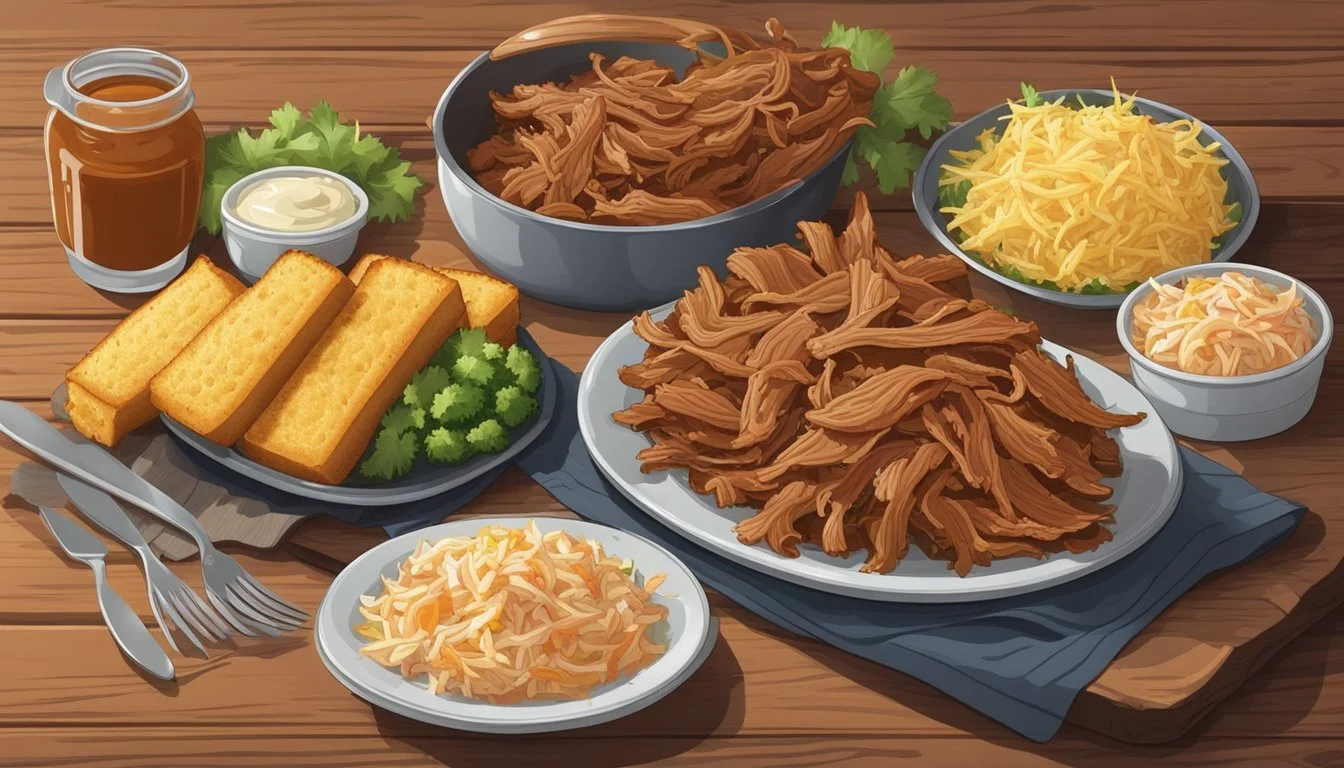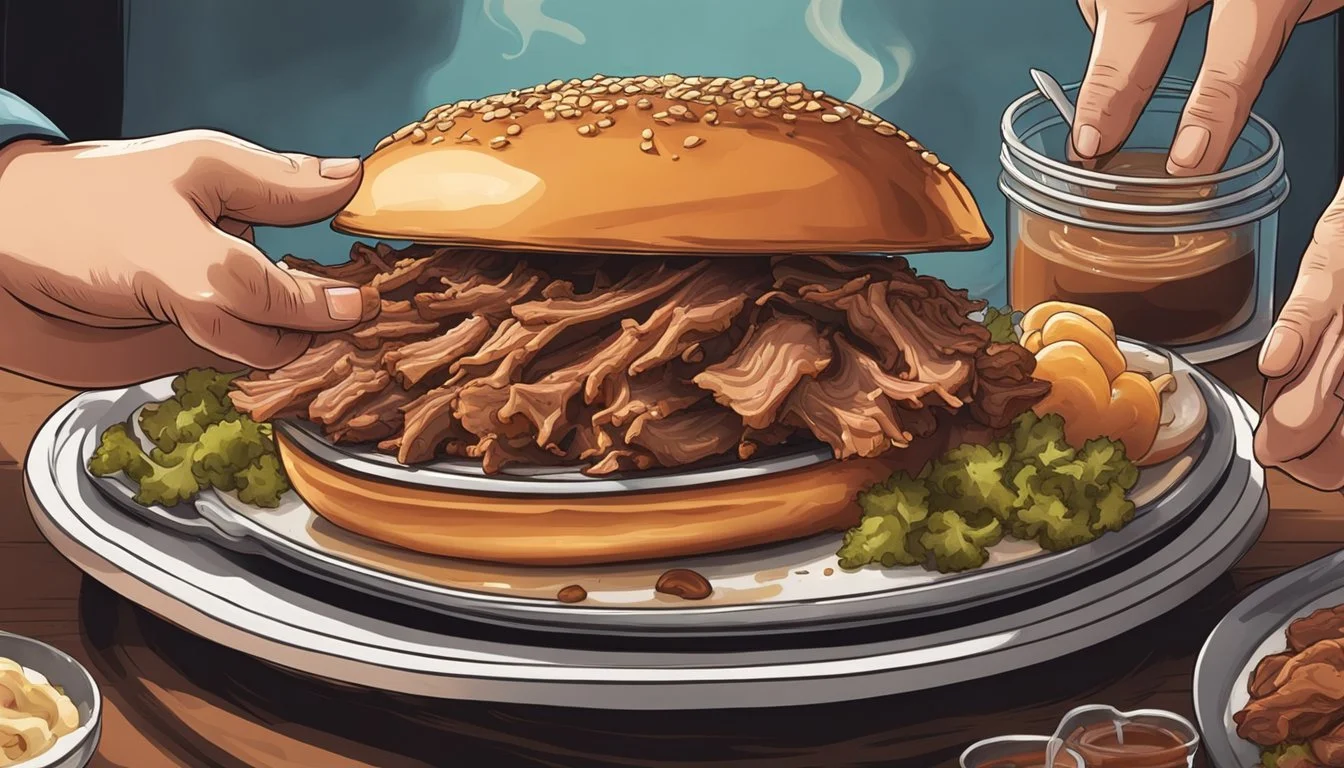Pulled Pork BBQ Perfection
Mastering the Art of Slow-Cooked Flavor
Pulled pork BBQ is a beloved American classic, a centerpiece at backyard gatherings and potluck dinners alike. This dish is renowned for its melt-in-the-mouth tenderness and robust flavors that come from a medley of spices, including black pepper, garlic (What wine goes well with garlic?) powder, (how long does garlic powder last?) and onion powder (how long does onion powder last?), carefully rubbed onto the pork before cooking. Typically prepared from the pork shoulder, or sometimes the pork butt, this cut is favored for its ideal balance of meat and fat, which contributes to a juicier result. The cooking process, whether done in an oven, slow cooker, or even an electric pressure cooker, transforms the meat into tender shreds that can be effortlessly pulled apart, hence the name "pulled pork".
The secret to perfecting pulled pork lies in the cooking time and temperature. It's about slowly bringing the pork to the right internal temperature, allowing the connective tissues to break down over several hours, which can range from 5-6 hours to as long as 12, depending on the cooking method. During this time, the pork absorbs the flavors of the BBQ sauce, which typically includes ingredients like apple cider vinegar (how long does apple cider vinegar last?) for tang, kosher salt (how long does kosher salt last?) for seasoning, and liquid smoke for an added depth of flavor, often finished with a dash of hot sauce (how long does hot sauce last?) for that extra kick.
Once cooked to perfection, the pork is pulled into bite-sized pieces, ready to be served atop soft buns with an extra spoonful of barbecue sauce or alongside a zesty coleslaw. For those aiming to capture the authentic BBQ essence, a homemade sauce recipe might include a blend of sweet, spicy, and tangy elements—enhanced with spices like chili powder and a teaspoon each of garlic and onion powders. Leftovers, if any, can be stored in an airtight container to retain the pork's juicy quality, ensuring the robust flavors endure for subsequent meals.
Selecting the Right Cut
When preparing pulled pork BBQ, the choice of meat cut is pivotal, impacting everything from flavor to texture.
Understanding Pork Butt and Shoulder
Pork Butt and Pork Shoulder are the most recommended cuts for creating decadent pulled pork. Though they are often used interchangeably, they are distinct:
Pork Butt (also known as Boston butt)
Origin: Higher on the foreleg
Texture: Well-marbled, which translates into more tenderness
Cooking: Suited for long, slow cooking methods for optimal tenderness
Pork Shoulder (also called picnic shoulder)
Origin: Lower on the foreleg
Consistency: Slightly less marbled than pork butt
Purpose: Still excellent for pulled pork, especially when enhanced with marinades or seasoning
Both cuts contain connective tissue that melts during the cooking process, rendering the meat tender enough to easily shred. Achieving the perfect internal temperature is crucial, typically around 195°F to 205°F for pulled pork, ensuring a juicy pork experience.
Bone-In vs. Boneless
Deciding between bone-in and boneless options is a matter of personal preference, each with its own merits:
Bone-In Pork Shoulder
Structure: The bone can contribute to a more uniform cook and deeper flavor.
Convenience: However, it requires skill to carve around once cooked.
Boneless Pork Shoulder
Practicality: Easier to handle and season with rubs like a mixture of teaspoon black pepper, garlic powder, and chili powder.
Yield: There is no need to carve around a bone, potentially offering more meat.
Regardless of the choice, seasoning the pork well with spices such as kosher salt and black pepper, along with adding liquids like apple cider vinegar, can enhance the flavor profile. Cooking the pork in a slow cooker or oven for several hours, often with the addition of BBQ sauce or a concoction of ingredients like garlic clove, yellow onion, and brown sugar, results in tender pork pieces ready to be served in pork sandwiches or as standalone dishes. Remember to store any leftovers in an airtight container to maintain freshness.
Preparation Techniques
Successful preparation of pulled pork hinges on attention to detail throughout the trimming, marinating, and tenderizing processes.
Trimming the Fat Cap
For the best texture and flavor, start by trimming the fat cap on the pork shoulder to about 1/8th inch thick. This layer of fat will melt over long cooking times, basting the meat and keeping it moist, while also imparting a rich flavor.
Marinating and Seasoning
Once trimmed, marinate or season your pork. A simple but effective mix may include kosher salt, black pepper, garlic powder, brown sugar, and a blend of pantry spices like onion powder and chili powder. Apply the seasoning liberally to infuse the pork with flavor. For deeper complexity, some cooks use a liquid mixture involving ingredients like apple cider vinegar, olive oil, or even a dash of liquid smoke sealed in an airtight container to permeate the meat.
Tenderizing the Meat
Cook the pork butt slow and low to break down the collagen, turning tough muscle into tender, juicy pork. Whether using a slow cooker, oven, or smoker, maintain an even temperature — around 225°F (107°C) is generally recommended. In a slow cooker, a medium heat setting typically suffices. For smokers, replenishment of coals and water is key to maintaining consistent temperature and moisture levels. The goal is to reach an internal temperature where the meat can easily be shredded, usually after about 5-6 hours, depending on the size of the cut.
Cooking Methods
The right cooking method can make the difference between dry, tough meat and a tender, juicy pulled pork masterpiece. Each approach offers a unique way to gently break down the pork's connective tissues, leading to the perfect texture for pork sandwiches and more.
Slow Cooking to Perfection
Slow cooking pulled pork in a slow cooker yields exceptionally tender pork. The low and slow method typically involves:
Cooking time: 5-6 hours on high heat or 10-12 hours on low heat.
Pork cuts: A bone-in pork shoulder or pork butt, seasoned with a rub containing kosher salt, teaspoon black pepper, teaspoon garlic powder, and tablespoon chili powder.
Liquids: A mix of bbq sauce, apple cider vinegar, and even a hint of liquid smoke to add depth of flavor.
Remember to keep the slow cooker covered throughout the cooking process to maintain the moisture inside.
Oven Roasting
Roasting pulled pork in the oven is another classic technique. Key steps include:
Preheat the oven to 275 degrees F to start.
Season the pork generously with a homemade rub blending garlic powder, teaspoon onion powder, black pepper, and teaspoons salt.
Cook until the pork reaches an internal temperature of 200-205 degrees F, which usually takes around 6 hours for an 8-pound pork roast.
To achieve extra flavor, baste the pork occasionally with a combination of bbq sauce and apple cider vinegar.
Once removed from the oven, it's critical to let the pork rest before shredding to retain the juices.
Instant Pot & Pressure Cooking
For a faster alternative, pressure cooking offers a time-saving solution:
Season the pork shoulder with spices like black pepper, garlic clove powder, (how long does clove powder last?) and kosher salt.
Sauté a yellow onion in the pot with vegetable oil (how long does vegetable oil last?) to lay a flavor foundation.
Pour in a braising liquid of choice - chicken stock, cola, or dark beer - into an Instant Pot or other electric pressure cookers along with the pork.
Cook under high pressure for about 90 minutes, then allow the pressure to release naturally.
Shred the pork inside the pot to let it soak up the aromatic juices, and if desired, stir in extra bbq sauce for a saucy finish.
Creating the Perfect BBQ Sauce
Crafting the optimal BBQ sauce involves a delicate balance of flavors and choosing between the personal touch of a homemade mixture or the convenience of a store-bought variety.
Combining Sweet and Savory
To achieve the perfect harmony of sweet and savory, a thorough selection of spices and seasonings is essential. Begin with a base of:
Tomato ketchup
A teaspoon of garlic powder
A tablespoon of chili powder
Teaspoon onion powder
For sweetness, brown sugar or honey is a staple, complemented by apple cider vinegar for tanginess. To deepen the flavor profile, Worcestershire sauce (how long does worcestershire sauce last?), liquid smoke, or even lemon juice can be added. For heat, consider a dash of cayenne or a swirl of hot sauce.
Salt balances the sauce, with kosher salt being a preferred choice for its clean taste. Black pepper adds a slight heat and earthiness, rounding off the flavors.
Combine these ingredients in a saucepan and simmer over medium heat, allowing them to marry together and develop a rich taste. Ensure to stir occasionally to prevent burning.
Homemade vs. Store-Bought
Customizable: Tailor the sweetness, spiciness, and tanginess to personal preference.
No additives: Avoid preservatives and create a natural taste.
Freshness: Made with freshly minced garlic cloves (how long do cloves last?) and diced yellow onions (What wine goes well with onions?) for extra flavor.
Storage Tip: Store in an airtight container in the refrigerator to maintain freshness.
Store-Bought BBQ Sauce:
Convenience: Ready to use; saves preparation time.
Consistency: Provides a stable flavor profile for repeated use.
Variety: Wide range of flavors and brands to choose from.
When selecting a sauce for your pork recipe, whether pre-made or self-crafted, consider the type of pork used. Pork butt or shoulder is ideal for tender pulled pork, particularly when cooked slow and low in a slow cooker or oven for the optimal internal temperature, ensuring juicy pork every time. Season the pork generously with the sauce and additional salt and spices for enhanced flavor. When serving, pork sandwiches may be heightened with a spoonful of extra BBQ sauce for added moisture and taste.
Serving and Presentation
When serving pulled pork BBQ, the key is to offer a balance of flavors and textures that complement the rich and savory meat.
Accompaniments and Sides
A well-rounded pulled pork meal features sides that add contrast to the main dish. Here are some popular options:
Slaw: A crunchy coleslaw, dressed with either mayonnaise or a vinaigrette made from apple cider vinegar, provides a tangy counterpoint to the juicy pork.
Cornbread: This sweet and savory bread pairs excellently with BBQ pulled pork. A jalapeño cheddar variety can offer an extra kick.
Potato Salad: Creamy potato salad, seasoned with kosher salt and black pepper, can balance the dish.
Beans: A side of beans, whether baked or stewed, adds a hearty element.
Mac and Cheese: This creamy, cheesy dish is a crowd pleaser and goes well with the tender pork.
When considering the serving size, plan for about 1/3 pound of pulled pork per person, taking into account that pork will lose about half its weight during cooking.
Sandwiches and Beyond
Pulled pork can be served beyond the traditional plate. Here are alternative ways to enjoy:
Sandwiches: Stuff a bun with shredded pork, topped with extra BBQ sauce or a vinegar-based sauce, and coleslaw for crunch.
Tacos, Quesadillas, Nachos: Use pulled pork as a filling along with a sprinkle of cheese, a dollop of Greek yogurt, and pickled jalapeños.
Burritos: Wrap pork with rice, beans, and cheese for a substantial meal.
When cooking, you can use a slow cooker, oven, or electric pressure cooker to achieve tender pork that easily shreds. Bone-in pork shoulder seasoned with the likes of garlic powder, teaspoon onion powder, and chili powder, and then cooked to the appropriate internal temperature, ensures a juicy and flavorful bite. For extra flavor, some cooks like to add a dash of liquid smoke or hot sauce to their BBQ sauce recipe.





